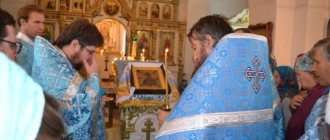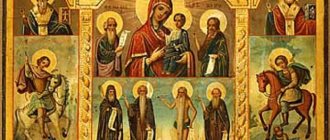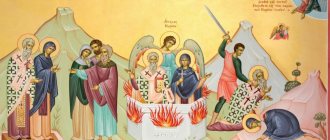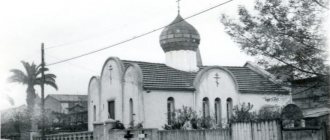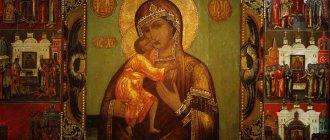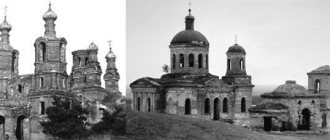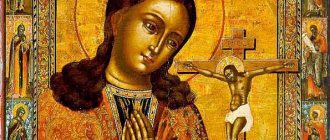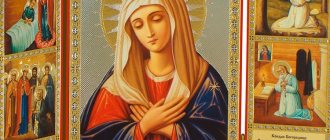The Icon of the Mother of God “Consolation and Consolation” is one of the main Orthodox shrines, which has been revered by faithful Christians of the world for centuries. Her story is simple and majestic at the same time: it contains fear and faith, an eternal cry for help and unquenchable hope. She is a true talisman that day after day gives God’s grace to everyone around her, revealing her wonderful deeds to each of them.
The history of the icon of the Mother of God “Consolation and Consolation”
Many miracles are associated with Mount Athos, where for many centuries the venerable elders found solitude and closeness to God. In one of the Greek monasteries, where men who have abandoned worldly life serve the Lord, a new image of the Mother of God was incarnated.
This happened on January 27, 807. At that time, the Vatopedi Monastery was in danger of an attack by robbers on the monastery. One of the abbots, who was spending time in prayer to the Mother of God, heard a woman’s voice and looked up at the icon. A voice warned the monk about the attack, and the face on the icon turned towards him. The abbot immediately called the brothers to testify to the miracle, and they were very surprised at the changes in the face. Kneeling down, the monks immediately gave thanks and offered a prayer in front of the icon of “Consolation and Consolation.” When the robbers approached the walls, they were unpleasantly surprised by the monks’ readiness to fight back. So, with the name of the Mother of God on their lips, the monks repelled the attack and defended the monastery.
Since then, the icon of “Consolation and Consolation” has become one of the revered faces of the Mother of God. She is in the same monastery where she came into the world.
The most famous miracle of healing with this image of “Consolation and Consolation” was the case of the monk Neophytos, who lived in the Vatopedi monastery. At that time, the abbot sent the monk to one of the monastery farmsteads located on the island of Euboea. During the process of completing his obedience, the monk fell ill and felt that he actually had little time left to live. Then he turned to the Mother of God with prayer, begging her to spare his life until the time when he could return to the monastery. Then he heard a woman’s voice saying that he could go back, but after a year, so that he would be ready for his dormition.
The illness released the monk from his hands, and after some time Neophyte returned to the monastery. On the morning of the day when a year had passed since his conversation with the Mother of God, he went to service and received Communion. Rising to his cell past the icon of “Consolation and Consolation,” the monk heard Her again. The Mother of God told him that the time had already come.
In the cell, the monk felt very weak and called the brothers. He told them about the miracle and went to God.
Icon of the Mother of God of Joy and Consolation of the Vatopedi Monastery, Athos.
The original image of the Mother of God “Consolation and Consolation” remains in the Vatopedi Monastery. The icon does not leave Mount Athos. There are lists from it in Russian churches. The most revered of them were:
List of the Resurrection Monastery. This icon is kept in the St. Petersburg monastery. She is always available for visiting. List of the Novodevichy Convent in Moscow. The icon was painted on Mount Athos. List of icons in the Dmitrievsky Monastery, located near Rostov the Great. During the Soviet era, it was lost, but in 1997, His Holiness Patriarch Alexy II of Moscow and All Rus', traveling with Metropolitan Juvenaly of Krutitsky and Kolomna, visited the monastery with the mission of returning the miraculous image.
The temple dedicated to the image of “Consolation and Consolation” was built on Khodynka Field at the very beginning of the twentieth century. After the actions of the Bolsheviks in the 20s, the temple was closed. It stood unkempt and was gradually falling apart. In the early 90s, the temple was transferred to the care of the Church, which became a new milestone in its existence. At the moment it is completely restored.
Finding and meaning of the holy image
The Mother of God icon “Consolation and Consolation” was painted in the second half of the 14th century. Until the moment when the image became miraculous, it hung among other images in the vestibule of the main temple. The monastery itself at that time resembled a fortress surrounded by high walls. Such precautions were taken for a reason - several times the shrine was attacked by bandits who wanted to rob the monks. Every day after sunset, the abbot locked the main gate and handed over the keys to the gatekeeper for safekeeping.
Legend has it that one day the abbot lingered in the vestibule and suddenly noticed that the face of the Mother of God had come to life. The comforter, turning her face to him, ordered him not to open the gate after the morning service, since robbers would hide behind them. She also ordered all the monks to climb the fortress walls to repel the robbers. Suddenly, the image of little Jesus began to move. The baby, raising his hand to the lips of the Mother of God, forbade Her to talk about the coming attack, since it was God’s punishment for monastic sins. However, the Blessed Virgin Mary leaned slightly to the right and again uttered a warning. In addition, She ordered sincere repentance for careless fulfillment of vows, so that Her Son would stop being angry with the monks.
The icon “Consolation and Consolation” was painted in the second half of the 14th century
Before the abbot had time to come to his senses, the figures froze and the image on the icon changed. Now the Mother of God leaned slightly to the right, slightly holding the hand of Her Son and looking at Him with boundless maternal love. The look of little Jesus became more stern, and infantile spontaneity disappeared from the childish image. After the monks, thanks to this miracle, were saved from robbers, they called the shrine “Consolation and Consolation.” Later, a separate temple was built for her, where the holy face remains to this day.
A lamp is constantly burning near the icon, services are held daily, and tonsures are also performed as monks.
The Vatopedi image belongs to the Hodegetria type of the Mother of God. Little Jesus, dressed in a green robe (symbol of the Holy Spirit), sits on the left forearm of the Mother of God. With his right hand he holds the scroll, and with his left he covers the lips of the Heavenly Intercessor. The Blessed Virgin Mary is dressed in scarlet robes, and her right hand carefully holds the wrist of her Son. This canonical image of the holy faces has its own meaning:
- no one will go unpunished for their sins;
- real righteous people must be brought up according to the laws of God;
- the Last Judgment is harsh but fair;
- God is merciful, and everyone can earn His mercy;
- The Lord is kind, and therefore forgives those who sincerely repent.
Revered lists of the miraculous icon
On the territory of Russia today you can venerate several copies of the famous Athos icon:
in the monastery in honor of the Resurrection of Christ in St. Petersburg; in the Athos Church on the territory of the Novodevichy Convent in Moscow. Icon of the Mother of God “Consolation and Consolation”
On the image kept in the Novodevichy Monastery by the hands of the Athonite elders, an inscription was made saying that through the prayers of the Most Holy Theotokos and the Ever-Virgin Mary, the grace of the Lord will not dry up on Russian soil as long as Russia as a state exists.
On the Khodynka field, where the barracks were once located, at the beginning of the 20th century, a church was erected in honor of the icon of the Mother of God of Delight and Consolation. This temple was destroyed in the 20s and restored after the fall of Soviet power.
The miraculous copy of the icon of the Most Holy Theotokos Delight and Consolation first appeared in Russia back in the 18th century. In Rostov the Great, where the Spaso-Yakovlevsky Monastery is located, one of the first icons copied from the Vatopedi image enjoyed special veneration. In 1518, two icons from the monastery were delivered to Russia by the Monk Maxim the Greek.
One of the icons brought then was part of the cell iconostasis of St. Demetrius of Rostov, and now you can venerate it in the Rostov Spaso-Jacob Monastery.
Meaning in Orthodoxy
The veneration of the Mother of God by Christians is easily explained. This is one of my favorite images. Intercessor, patroness, mentor, mother of everything and everyone, who comprehended the depth of great grief and knew the price of sacrifice. This is exactly how the Mother of God appears.
Vatopedi belongs to the group of places that are most visited by pilgrims from all over the world. Christians strive to express their respect and see “Consolation and Consolation” with their own eyes.
What does the “Consolation and Consolation” icon help with?
It is precisely because of such unique content that this image often helps believers protect themselves from various adversities. For example, there is much evidence of how lists of icons were used to make religious processions around cities that were subject to epidemics. If people there sincerely repented, then the illness receded.
In addition, the holy image is known as a protector from any other misfortunes, from the invasion of foreigners, from various diseases and natural disasters. In addition, they pray to her in order to overcome internal enemies: passions and propensities for sins.
Home iconostasis: tips and prohibitions
When you have decided on a place for the icon case, you should start arranging it. Here are some tips:
- First of all, it is necessary to securely secure the shelf for the relics. You can make it yourself or purchase it at a church store. Such a stand should be at eye level of the person praying. Cover the base with an embroidered napkin, towel or clean white cloth;
- the principles for placing images must correspond to the layout of the church. So, the shrine of Jesus Christ should be placed on the right side, and the face of the Virgin Mary on the left side. Let’s assume another option - when the icon of the Lord is in the center, and on the right hand of it (respectively, to the left of the person praying) a relic of the Virgin Mary is hung. In this case, to the left of the Savior you can attach a work that depicts Nicholas the Wonderworker or John the Baptist;
- at the right hand of the shrine of the Mother of God is the image of the Archangel Michael, and at the right hand of the icon of John the Baptist is the image of the Archangel Gabriel;
- Above the relic of the Son of God, only the Crucifix or the image of the Holy Trinity can be placed. By the way, any icon case should be crowned with a cross;
- The iconostasis also includes other relics of revered righteous people - for example, the healer Panteleimon or St. George the Victorious. However, they should all hang under the faces of the Holy Family, Jesus Christ, the Heavenly Queen and the Apostles;
- personal, family and hereditary shrines are placed even lower;
- When praying, a candle or lamp is sure to be lit near the images. Living fire personifies the burning of faith, passion and conviction with which you pronounce the words of psalms, troparions and praises.
There are also some prohibitions regarding where the icon should hang in the house. So, it is impossible for relics to be located next to a TV, tape recorder, computer and other household appliances. Shrines should not alternate with paintings, books (even essays on Christian themes), photographs, panels or reproductions, posters, wall calendars and decorative items (figurines, interior accessories). In addition, many theologians advise placing religious works on a shelf rather than hanging them to avoid unwanted associations with hanged people.
These tips will help you find the best place to place your heirlooms. And so that prayers bring only joy, peace and grace, our online store “Amber of Polesie” will provide you with durable, expressive and spiritual icons, handmade from natural solar gems. Here you can choose both images of the Savior and the Virgin Mary, as well as a variety of personalized shrines, amulet and Christian amulets.
The meaning of the icon “Consolation and Consolation”
The meaning of the icon is truly enormous, because all its power lies in it. The holy face is still located in the monastery on Mount Athos to this day, and its origins go back to the 14th century. It is also interesting that the image is only partly man-made, because it was not originally written on a board, like similar relics. And even earlier it was completely part of the wall painting, which was later removed and in its original form was enclosed in an icon case (a glass box for icons).
It is very beautiful and artistically rich, and its frame is a real masterpiece of icon painting. A very small number of people saw her in full, but the eyes of the Mother of God, which are always clearly visible on the holy face, are so penetrating and pure that sometimes it seems as if they are looking into the very soul of a person and understanding everything that he is silent about. It was they who became the symbol of true salvation for many Christians for many centuries and remain so to this day.
The icon was painted in memory of the miraculous return of the young prince Arkady, who was saved thanks to the intercession of the Mother of God. Since then, she has been revered among believers as one who prevents all sorts of troubles and helps in the most seemingly hopeless situations, which often threaten human life and health.
Must read: Saint Tarasius, Patriarch of Constantinople
There are cases when the image of the Mother of God became not only the only salvation, but also a symbol of acquired faith, which remained with a person for the rest of his life and led him along complex paths, giving strength and presenting real miracles. It is not just consolation and joy, it gives the opportunity to understand the world around us, and, having learned this great meaning, the Christian himself gained freedom and peace of mind, which led him along the righteous path to eternal life.
History of appearance and acquisition
The discovery of the Vatopedi icon is associated with the events of 807. According to the chronicles, the abbot of the Athos monastery traditionally performed prayers in front of the iconostasis, among which there was a canonical image of the Mother of God with Jesus.
Suddenly the image began to move, the mother turned her head to the right and warned the abbot about the attack of the robber detachment on the monastery. After the attack was repelled, the abbot of the monastery returned to the iconostasis. He saw that the figures on the canvas had completely changed their position. This was an unprecedented miracle, about which rumors immediately spread.
The monks of the monastery considered the baby’s gesture to be a desire to prevent the mother from uttering a warning. They began to pray more earnestly, hoping to earn God's blessing. Because of this, the painting received another interpretation. According to many chroniclers, the Mother of God, frozen on the canvas, acts as an intercessor of people who convinces her strict son to be more lenient.
What and who does the icon of the Mother of God “Consolation and Consolation” help with?
Icon of the Mother of God of Joy and Consolation
The uniqueness of the image made the icon one of the most revered. The unity of dissimilar, even contradictory features became the basis of a real amulet against many problems. The icon of the Mother of God “Consolation and Consolation” is addressed in the following cases:
when the cities were devastated by the pestilence, the copies from the icon were carried in a religious procession, during which many sinners repented, so the trouble went away; if there was a threat of foreign attack, people turned to the icon and its copies for help, which helped eliminate the danger; often the relatives of sick people or sick believers themselves turn to the icon with a request for healing; when natural disasters occur, the image is approached with a request for protection; if there is a tendency to sin, strong sinful passions, “Consolation” helps to cope with them and get rid of them; if you need to find your peace and spiritual integrity in life, of course, prayer to the Mother of God at this icon helps to bring the soul into harmony with the world; when there is a threat of a panic attack, you just need to turn to the image, and calmness will take fear and weakness aside, and give you the strength to withstand even the most unpleasant situations; if there is no order in life, and misfortunes often occur, turning to the icon helps to ward off misfortunes; prayer directly to the icon of the Mother of God “Consolation and Consolation” helps to get rid of mental ulcers; for those who are weak in faith, the icon helps strengthen it; the icon will protect you from enemies, you just have to ask the Mother of God about it.
How to ask for help
To turn to an icon, you must have the image itself and faith in God. You should not think that such an appeal is possible only in a church where there is an ancient list of the face.
You can pray at home by picking up an inexpensive icon from an ordinary church store. It is advisable not to change the text of the prayer, but to read it in its entirety. Only at the very end can you add words coming from the heart.
When you turn to God and the Mother of God, do not forget about your sinfulness. It is also necessary to remember the mercy of God given to us through the Atonement. The very name of the image says that God gives a second chance to everyone who seeks it and is ready to atone for their sins.
We should not assume that God divides people into those who are more worthy of grace and those who deserve it less. In fact, He always hears us, and He does not divide the problems with which we turn to Him into more or less important. Believe! Ask! And new opportunities and support will be given to the one who asks.
You should not extol yourself or show humility, show meekness, feeling a storm inside. Humble the sinful fire of pride in your soul and repentantly venerate the icon. The Mother of God sees true reverence and humility and transforms it spiritually.
Prayer to the Blessed Virgin Mary
There are three main prayers to the icon of the Mother of God “Consolation and Consolation”. Choose the one that suits you best.
Text of the prayer to the icon of the Mother of God “Consolation and Consolation” about gratitude, consolation, humility and deliverance from sins:
»change font Oh, Most Holy Lady Theotokos, Our Joy and Consolation! Look mercifully at the people who stand with faith and love and worship Your Most Pure Image, accept our singing of praise and pour out Your warm prayer for us sinners to the Lord, so that, despising all our sins, He will save and have mercy on us, O Most Precious Lady! Show us Your wonderful mercies, save the shepherds of the Church and the entire Christian army. We pray to You with tenderness, deliver us all from all sorrow, guide us on the path of all virtues and goodness, save us from temptations, troubles and illnesses and take away slander and quarrels from us, save us from lightning thunder, from the flood of fire, from hail, cowardice, flood and deadly plagues, grant us Your merciful help on the way, and at sea, and on land. Behold, O All-Merciful Lady, in undoubted hope we offer to You our wretched prayer. Do not reject our tears and sighs, do not forget us all the days of our life, but always remain with us, and through Your intercession and intercession with the Lord, give us joy, consolation, protection and help, so that we glorify and magnify, and please You throughout all generations. forever and ever. Amen.
Text of the prayer to the icon of the Mother of God “Consolation and Consolation” for intercession, strengthening faith and deliverance from sins:
»change font Hope to all ends of the earth, Most Pure Virgin Mary, Our Consolation and Joy! Do not disdain us sinners, for we trust in Your mercy. Quench the flame of sin and water our withered hearts with repentance. Cleanse our minds from sinful thoughts. Accept prayers offered to You from your soul and heart with sighing. Be an intercessor for us to Your Son and God and turn His anger away from us with Mother’s prayers. Strengthen the Orthodox faith in us, put in us the spirit of the fear of God, the spirit of humility, patience and love. Heal mental and physical ulcers, calm the storm of evil enemy attacks. Take away the burden of our sins and do not leave us to perish until the end. Grant us Thy mercy and Thy holy blessing to all those present and praying here, and always remain with us, giving those who come to You joy and consolation, help and intercession, may we all glorify and magnify You until our last sigh. Amen.
Text of the prayer to the icon of the Mother of God “Consolation and Consolation” about guidance on the truth, salvation and enlightenment:
»change font O Most Holy Virgin, Mother of the Lord, Queen of Heaven and Earth! Hear the much-painful sighing of our soul, look down from Thy holy height upon us, who with faith and love worship Thy Most Pure Image. We are immersed in sins and overwhelmed by sorrows, looking at Your image, as if You were alive and living with us, we offer our humble prayers. Imams have no other help, no other intercession, no consolation except You, O Mother of all who mourn and are burdened! Help us the weak, satisfy our sorrow, guide us who are erring on the right path, heal and save the hopeless, grant us the rest of our lives to spend in peace and silence, grant us a Christian death, and at the terrible judgment of Your Son, appear to us the Merciful Intercessor, may we always sing , we magnify and glorify Thee, as the good Intercessor of the Christian race, with all those who have pleased God. Amen.
We share with you the reading of the prayer before the icon of the Mother of God of Rejoicing and Consolation performed by the ministers of the Cathedral of the Mother of God in the city of Kropotkin:
Prayer before the icon of the Mother of God, called Otrada and Consolation.
In what cases should one pray to an icon?
Work as a courier at Yandex.Eda (up to 3,400 rubles per shift) leave a request →
The miraculous icon “Consolation and Consolation” helped the Athonite monks prevent the plunder of the monastery. A woman’s voice came from the image, saying that there was no need to open the doors of the monastery. There was another unusual incident - the poses on the icon changed - Christ tried to block the Mother’s mouth with his hand, because he wanted the monks to be punished for becoming careless in their duties.
Since then, the image has become known throughout the Christian world. Since the icon of “Consolation and Consolation” resides on Mount Athos, it is possible that prayers to it were written by monks - ascetics of faith and piety. There are several revered lists in Russia:
- one of them is located in the Resurrection Monastery (St. Petersburg);
- in the Athos Church of the Novodevichy Convent (Moscow) - written on the holy mountain.
The very beautiful Temple of the Icon of the Mother of God “Consolation and Consolation” was built at the beginning of the last century on Khodynka Field. There used to be barracks here. The Bolsheviks closed the church in the 20s and partially damaged it. Restoration began after the building was handed over to the Church in the early 90s. Fortunately, the unique architectural appearance of the temple was able to be recreated. This is truly a beautiful creation of architecture.
But you can pray before the icon of the Mother of God “Consolation and Consolation” at home. To do this, purchase a copy from the church shop. You will find the text of the required prayer on our website (as well as many others). It is advisable to adhere to it, only at the end you can add something in your own words. During a conversation with God and the Queen of Heaven, one should remember both one’s sins and the mercy of God. The very name of the image already contains hope for forgiveness.
For some reason, many people believe that for every problem there is a strictly defined image, saint or prayer. In fact, the Lord does not distribute grace to those who deserve it more, because every person is a sinner. God does not have office hours, does not divide problems into “big” and “small” with which He cannot be disturbed. Therefore, the pious tradition should not be turned into pagan beliefs.
In the gospel stories we are clearly shown how Christ granted mercy and forgiveness to those who did not deserve them, but who persistently prayed. You have to believe, keep asking - and it will be given to you! God help you!
The history of the glorification of the icon
The glorification of the icon of the Mother of God “Consolation and Consolation” began with the amazing miracle of changing the faces on one of the icons of the Vatopedi Monastery on Athos.
Vatopedi Icon of the Mother of God “Consolation and Consolation”
This happened in 807 on January 21 in the Annunciation Church. At the end of Matins, only the abbot of the monastery remained in the church. Standing near one of the Mother of God icons, he heard a woman’s voice who told him that today he needed to keep the monastery gates locked, otherwise trouble would not be avoided. It was none other than the Mother of God herself who spoke these words twice.
But it was not only the woman’s voice that the abbot of the monastery heard. He also heard the stern words of Christ stopping His Mother: “May they be punished for their sins...”.
The abbot raised his eyes to the image of the Mother of God and saw that her head had become turned to the right, and the face of Christ had become more stern. Now the Baby seemed to be blocking the mouth of His Mother, not allowing her to warn the inhabitants of the monastery about the impending attack by robbers.
Immediately gathering the brethren in the temple, the abbot showed the monks the miraculously changed icon. After a prayer of thanks, all the inhabitants of the monastery, according to the word of the Mother of God, gathered on the wall of the monastery and repelled the attack of the robbers.
Attention! In gratitude for the consolation and protection of the monastery, the monks even today keep a lamp in front of the icon of the Mother of God “Consolation and Consolation” constantly burning.
The miracle of the appearance of the image happened on January 21, this happened even before the calendar changed. Therefore, today the memory of the icon of Joy and Consolation is celebrated on February 3 according to the new style.
History of the monastery and icons
On Holy Mount Athos in Greece stands one of the oldest Orthodox monasteries - Vatopedi. In the Church of the Annunciation of this famous monastery there are several miraculous icons of the Mother of God, one of which is called the icon of the Vatopedi Mother of God.
The history of this monastery dates back to the reign of Theodosius the Great and the miraculous salvation of his son Arkady. The king's heir, while taking a boat trip, fell from a sailboat into the water not far from the monastery. But an incredible miracle happened, he did not die. The Mother of God saved the young man and carried him to the shore unharmed. People rushing to help found the youth near a bush near the monastery. In memory of these events, the monastery began to be called Vatopedi. The Greek word "vatoped" is translated as "bush, child, youth." The gratitude and generosity of the holy king Theodosius towards the monastery knew no bounds.
Prayers
The day of veneration of the image is February 3.
Troparion to the Most Holy Theotokos before the icon of Her Vatopedi, called “Consolation” or “Consolation”, tone 4
As the gracious and saving cover/ of the acquirer of Thy honorable icon, Mother of God,/ looking at this with tenderness, we cry out to Thee:/ Lady, grant us joy and consolation,/ for I trust in Thee We place our trust in sin and humility./ We hope in Your intercession, unworthiness./ Hasten to deliver us from troubles and sorrows/ and beg Thy Son, Christ our God,// to have mercy and save our souls.
Troparion to the Most Holy Theotokos before the icon of Her of Vatopedi, called “Consolation” or “Consolation”
We are now diligent to the Mother of God, / sinners and humility, and let us fall, / calling in repentance from the depths of our souls: / Lady, help, who have had mercy on us, / struggling, we are perishing from many sins ./ Do not turn away your vain slaves, // You and the one hope of the imams.
Kontakion to the Most Holy Theotokos before the icon of Her Vatopedi, called “Consolation” or “Consolation”, tone 8
To the chosen Voivode, victorious,/ as having got rid of the evil ones,/ let us write thanksgiving to Thee, Thy servants, to the Mother of God,/ but, as having an invincible power,/ free us from all troubles, let us call Thee: // Rejoice , Bride Non-bride.
What do they ask for in front of the icon?
The celebration takes place on February 3. Before the face they ask for the following:
- that sins or mistakes may be forgiven;
- about receiving consolation after the death of relatives and friends;
- to avoid God's wrath after doing wrong.
The Mother of God traditionally helps mothers when they pray for protection, help for children, and guidance for the lost.

